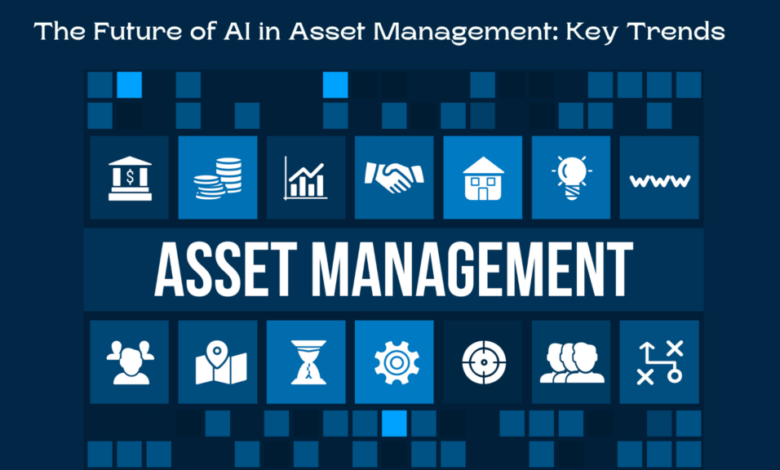
The integration of Artificial Intelligence (AI) in asset management is reshaping how asset managers approach everything from algorithmic trading to client services. By harnessing technologies like machine learning, predictive analytics, and deep learning, asset management firms are transforming their strategies to offer more efficient, personalized, and proactive services. This digital transformation, forecasted to generate approximately $2.8 trillion by 2030, marks a significant evolution in the sector.
Key Trends in AI-Driven Asset Management
The asset management industry stands on the brink of a technological revolution, driven by the rapid advancement of Artificial Intelligence (AI). As AI technologies evolve, they are increasingly becoming integral to asset management, transforming traditional practices and establishing new norms.
The future of AI in asset management is laden with transformative potential, reshaping industry practices through innovative trends. By incorporating fixed asset management software offers rapid integration and configuration, the platform meets complex requirements swiftly, customizing a system that aligns perfectly with your needs. This integration centralizes asset data, providing a view of your asset base and balance sheet, and connects seamlessly to various sources of asset, service, cloud, and accounting data with automatic updates.
As AI continues to evolve, its role in transforming financial technology becomes increasingly critical, paving the way for a new era in asset management. This section explores the most significant AI-driven trends that are reshaping the asset management landscape today. Each trend underscores the pivotal role of AI in driving forward-looking, data-driven decision-making processes that promise to redefine success in asset management.

Comparison Table: Traditional vs. AI-Driven Asset Management:
This table illustrates the clear advantages of AI-driven management over traditional methods, particularly in terms of efficiency, accuracy, and proactive capabilities. This shows the transformative impact of AI on the asset management industry.
| Features | Traditional Management | AI-Driven Management |
| Data Processing Speed | Moderate | High |
| Decision-Making Accuracy | Variable | Highly Accurate |
| Risk Management | Reactive | Proactive |
| Operational Efficiency | Standard | Highly Optimized |
| Regulatory Compliance | Challenging | Streamlined |
Enhanced Data Processing and Analysis
The rapid advancement of AI technologies has significantly impacted how asset management firms handle data. Traditional data processing methods, which are often time-consuming and prone to human error, are being replaced by AI-driven systems capable of analyzing large datasets with unprecedented speed and accuracy.
These AI systems use machine learning algorithms to recognize patterns and anomalies that would be invisible to human analysts. This leads to faster response times, more accurate market predictions, and a better understanding of client needs.
Key Benefits:
- Increased Efficiency: AI can process and analyze data up to 30% faster than traditional methods.
- Reduced Errors: Automation minimizes the risks of human error in data handling.
- Customized Strategies: Advanced analytics enable personalized investment strategies based on individual client data.
Predictive Insights and Forecasting
Predictive analytics is another area where AI is making a significant mark in asset management. Using historical data and machine learning models, AI forecasts market trends, asset price movements, and potential investment risks with greater accuracy. This capability allows asset managers to make proactive adjustments to portfolios, mitigating risks before they impact investment returns.
Key Benefits:
- Market Trend Analysis: AI identifies long-term market trends and potential shifts in market dynamics.
- Risk Assessment: Early identification of potential risks, allowing for timely strategic adjustments.
- Investor Behavior Insights: Understanding and predicting client behaviors to better align investment strategies with client expectations.
Real-Time Risk Management and Fraud Detection
AI excels in identifying patterns and anomalies in real-time, which is crucial for effective risk management and fraud detection in asset management. AI-powered systems continuously monitor transactions and portfolio activities, flagging unusual actions that could indicate fraudulent behavior or unintentional high-risk events. Immediate detection is vital in a landscape where seconds can make the difference between minimal impact and significant financial loss.
Key Benefits:
- Immediate Response: Quick detection and response to potential threats.
- Continuous Monitoring: 24/7 monitoring without the need for breaks or downtime.
- Data Analysis: Utilizing vast amounts of historical data to predict and mitigate future risks.
Improved Decision-Making and Operational Efficiency
AI is transforming decision-making processes in asset management by automating routine tasks and providing comprehensive analytics. This frees up asset managers to focus on more complex decisions that require human insight. Additionally, AI can optimize internal operations by identifying inefficiencies and suggesting improvements, leading to significant cost reductions and enhanced productivity.
Key Benefits:
- Automated Routine Tasks: Freeing up professionals to focus on higher-level strategic thinking.
- Cost Reduction: Minimizing operational costs through efficient processes.
- Productivity: AI’s ability to handle multiple tasks simultaneously increases overall firm productivity.
Adoption of Generative AI
Generative AI is among the latest innovations being adopted within asset management. These AI systems can generate new data instances and simulations that mimic real-world assets and market conditions, allowing asset managers to test various investment strategies and scenarios before applying them in the real world. This capability is particularly useful in asset management, where understanding potential outcomes under different market conditions is crucial.
Key Benefits:
- Scenario Analysis: Testing investment strategies under various simulated market conditions.
- Innovation in Asset Strategies: Creating novel investment strategies based on generated data.
- Customization: Tailoring portfolios more accurately to meet specific client goals and risk profiles.
Regulatory Challenges and Compliance
As AI becomes more integrated into asset management, regulatory bodies are stepping up to ensure these technologies are used ethically and in compliance with financial regulations. Navigating this regulatory landscape can be challenging, but AI also helps with compliance management by monitoring regulatory changes and ensuring portfolio adjustments are made in real time.
Key Benefits:
- Compliance Monitoring: AI systems keep track of regulatory changes and ensure compliance.
- Risk Reduction: Reducing legal and financial risks associated with non-compliance.
- Governance Frameworks: AI helps in implementing robust governance frameworks that align with both company policies and regulatory requirements.
These expanded sections provide a deeper insight into how AI is reshaping asset management, and enhancing capabilities while introducing new tools and strategies to navigate the complex landscape of modern financial markets. Each of these key trends not only offers a specific advantage but also complements the others, collectively advancing the sector towards more secure, efficient, and client-focused outcomes.
Integration of AI with Other Emerging Technologies
The convergence of AI with blockchain, big data, and the Internet of Things (IoT) is creating synergistic effects that enhance the capabilities of asset management firms beyond traditional measures. AI algorithms are now capable of interacting seamlessly with blockchain to ensure tamper-proof record-keeping and transparent audit trails, crucial for financial transactions.
Similarly, IoT devices facilitate real-time data collection from a multitude of sources, which AI systems analyze to gain deeper insights into market conditions and client behavior. The integration of big data technologies allows for the handling and analysis of these vast datasets, enabling more accurate predictions and strategic decision-making.
For instance, blockchain can provide the foundation for creating decentralized financial (DeFi) services, where AI can be used to manage and secure automated financial transactions without the need for traditional financial intermediaries. This integration is pivotal for asset managers looking to leverage cutting-edge technology to offer enhanced solutions that meet the evolving demands of modern investors.
The Future Outlook for AI in Asset Management
As we look to the future, AI’s role in asset management is expected to not only grow but become a cornerstone of industry practice. By 2034, with the market for generative AI within asset management predicted to reach approximately $21.82 billion, the influence of AI is set to deepen, driven by continual advancements in AI capabilities and broader acceptance among financial institutions. Asset managers will likely rely on AI for a range of functions, from operational to client engagement, using more sophisticated tools that offer greater precision and efficiency.
Moreover, as AI technology evolves, we can anticipate new types of AI emerging that will further refine and redefine the possibilities within asset management. These advancements will likely spur the development of new financial instruments and investment vehicles, offering both higher returns and better risk management.
In response, asset management firms must stay agile, ready to adopt new technologies and strategies to fully harness AI’s potential. This ongoing adaptation will be crucial in maintaining competitiveness in a rapidly shifting financial landscape, where technology increasingly dictates market dynamics.
Conclusion
As we have seen, AI is set to redefine the asset management landscape profoundly. From enhancing data processing capabilities to managing compliance and everything in between, AI’s role is both transformative and expansive. Asset managers must stay informed and agile, adapting to these advancements to maintain a competitive edge in a rapidly evolving industry.
Frequently Asked Questions
- What are the main challenges of integrating AI in asset management?
Challenges include navigating complex data privacy issues, adhering to stringent regulatory requirements, and ensuring the ethical application of AI in decision-making processes.
- How is AI affecting jobs in the asset management industry?
AI is automating routine tasks, allowing professionals to focus on higher-value strategic and analytical roles, thus reshaping career paths within the industry.
- Can AI in asset management lead to better investment returns?
Yes, AI can significantly enhance investment returns by enabling more precise and timely decision-making, although outcomes vary based on specific strategies and market conditions.
Balla




